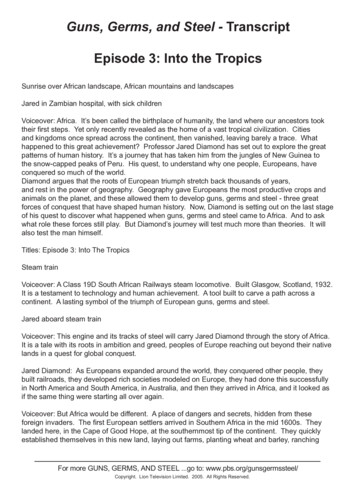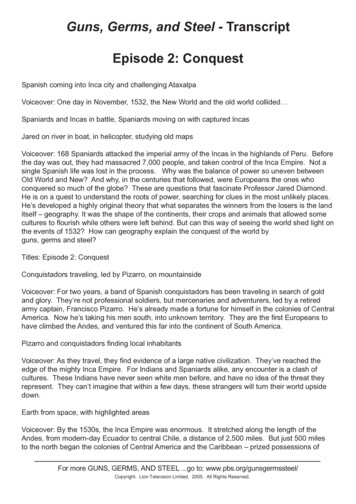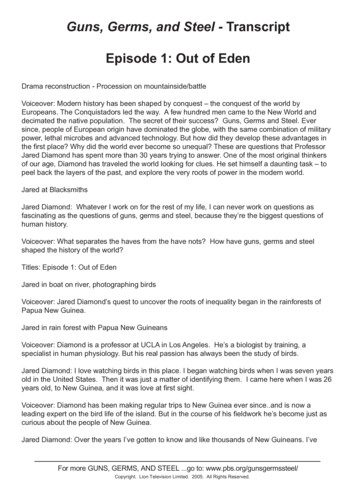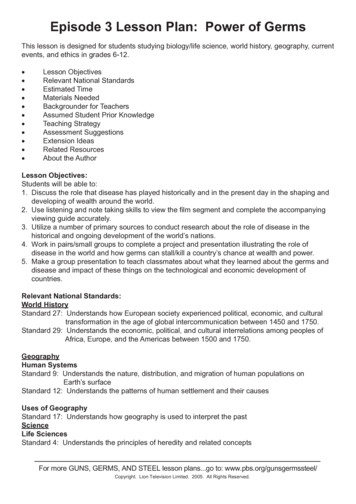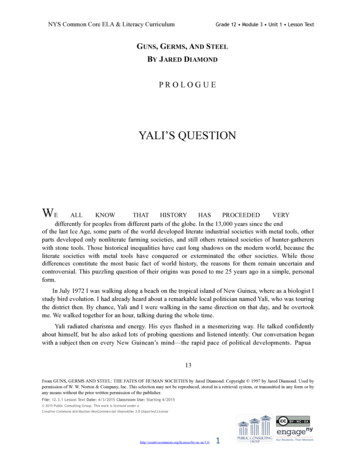
Transcription
NYS Common Core ELA & Literacy CurriculumGrade 12 Module 3 Unit 1 Lesson TextGUNS, GERMS, AND STEELBY JARED DIAMONDPROLOGUEYALI’S ently for peoples from different parts of the globe. In the 13,000 years since the endof the last Ice Age, some parts of the world developed literate industrial societies with metal tools, otherparts developed only nonliterate farming societies, and still others retained societies of hunter-gathererswith stone tools. Those historical inequalities have cast long shadows on the modern world, because theliterate societies with metal tools have conquered or exterminated the other societies. While thosedifferences constitute the most basic fact of world history, the reasons for them remain uncertain andcontroversial. This puzzling question of their origins was posed to me 25 years ago in a simple, personalform.In July 1972 I was walking along a beach on the tropical island of New Guinea, where as a biologist Istudy bird evolution. I had already heard about a remarkable local politician named Yali, who was touringthe district then. By chance, Yali and I were walking in the same direction on that day, and he overtookme. We walked together for an hour, talking during the whole time.Yali radiated charisma and energy. His eyes flashed in a mesmerizing way. He talked confidentlyabout himself, but he also asked lots of probing questions and listened intently. Our conversation beganwith a subject then on every New Guinean’s mind—the rapid pace of political developments. Papua13From GUNS, GERMS AND STEEL: THE FATES OF HUMAN SOCIETIES by Jared Diamond. Copyright 1997 by Jared Diamond. Used bypermission of W. W. Norton & Company, Inc. This selection may not be reproduced, stored in a retrieval system, or transmitted in any form or byany means without the prior written permission of the publisher.File: 12.3.1 Lesson Text Date: 4/3/2015 Classroom Use: Starting 4/2015 2015 Public Consulting Group. This work is licensed under aCreative Commons Attribution-NonCommercial-ShareAlike 3.0 Unported a/3.0/!1
NYS Common Core ELA & Literacy Curriculum14Grade 12 Module 3 Unit 1 Lesson TextPROLOGUENew Guinea, as Yali’s nation is now called, was at that time still administered by Australia as a mandateof the United Nations, but independence was in the air. Yali explained to me his role in getting localpeople to prepare for self-government.After a while, Yali turned the conversation and began to quiz me. He had never been outside NewGuinea and had not been educated beyond high school, but his curiosity was insatiable. First, he wantedto know about my work on New Guinea birds (including how much I got paid for it). I explained to himhow different groups of birds had colonized New Guinea over the course of millions of years. He thenasked how the ancestors of his own people had reached New Guinea over the last tens of thousands ofyears, and how white Europeans had colonized New Guinea within the last 200 years.The conversation remained friendly, even though the tension between the two societies that Yali and Irepresented was familiar to both of us. Two centuries ago, all New Guineans were still “living in theStone Age.” That is, they still used stone tools similar to those superseded in Europe by metal toolsthousands of years ago, and they dwelt in villages not organized under any centralized political authority.Whites had arrived, imposed centralized government, and brought material goods whose value NewGuineans instantly recognized, ranging from steel axes, matches, and medicines to clothing, soft drinks,and umbrellas. In New Guinea all these goods were referred to collectively as “cargo.”Many of the white colonialists openly despised New Guineans as “primitive.” Even the least able ofNew Guinea’s white “masters,” as they were still called in 1972, enjoyed a far higher standard of livingthan New Guineans, higher even than charismatic politicians like Yali. Yet Yali had quizzed lots of whitesas he was then quizzing me, and I had quizzed lots of New Guineans. He and I both knew perfectly wellthat New Guineans are on the average at least as smart as Europeans. All those things must have been onYali’s mind when, with yet another penetrating glance of his flashing eyes, he asked me, “Why is it thatyou white people developed so much cargo and brought it to New Guinea, but we black people had littlecargo of our own?”It was a simple question that went to the heart of life as Yali experienced it. Yes, there still is a hugedifference between the lifestyle of the average New Guinean and that of the average European orAmerican. Comparable differences separate the lifestyles of other peoples of the world as well. Thosehuge disparities must have potent causes that one might think would be obvious.Yet Yali’s apparently simple question is a difficult one to answer. I didn’tYALI’ S QUESTION15have an answer then. Professional historians still disagree about the solution; most are no longer evenasking the question. In the years since Yali and I had that conversation, I have studied and written aboutother aspects of human evolution, history, and language. This book, written twenty-five years later,attempts to answer Yali.From GUNS, GERMS AND STEEL: THE FATES OF HUMAN SOCIETIES by Jared Diamond. Copyright 1997 by Jared Diamond. Used bypermission of W. W. Norton & Company, Inc. This selection may not be reproduced, stored in a retrieval system, or transmitted in any form or byany means without the prior written permission of the publisher.File: 12.3.1 Lesson Text Date: 4/3/2015 Classroom Use: Starting 4/2015 2015 Public Consulting Group. This work is licensed under aCreative Commons Attribution-NonCommercial-ShareAlike 3.0 Unported a/3.0/!2
NYS Common Core ELA & Literacy CurriculumGrade 12 Module 3 Unit 1 Lesson TextALTHOUGH YALI’ S QUESTION concerned only the contrasting lifestyles of New Guineans and ofEuropean whites, it can be extended to a larger set of contrasts within the modern world. Peoples ofEurasian origin, especially those still living in Europe and eastern Asia, plus those transplanted to NorthAmerica, dominate the modern world in wealth and power. Other peoples, including most Africans, havethrown off European colonial domination but remain far behind in wealth and power. Still other peoples,such as the aboriginal inhabitants of Australia, the Americas, and southernmost Africa, are no longer evenmasters of their own lands but have been decimated, subjugated, and in some cases even exterminated byEuropean colonialists.Thus, questions about inequality in the modern world can be reformulated as follows. Why did wealthand power become distributed as they now are, rather than in some other way? For instance, why weren’tNative Americans, Africans, and Aboriginal Australians the ones who decimated, subjugated, orexterminated Europeans and Asians?We can easily push this question back one step. As of the year A.D. 1500, when Europe’s worldwidecolonial expansion was just beginning, peoples on different continents already differed greatly intechnology and political organization. Much of Europe, Asia, and North Africa was the site of metalequipped states or empires, some of them on the threshold of industrialization. Two Native Americanpeoples, the Aztecs and the Incas, ruled over empires with stone tools. Parts of sub-Saharan Africa weredivided among small states or chiefdoms with iron tools. Most other peoples—including all those ofAustralia and New Guinea, many Pacific islands, much of the Americas, and small parts of sub-SaharanAfrica—lived as farming tribes or even still as hunter-gatherer bands using stone tools.Of course, those technological and political differences as of A.D. 1500 were the immediate cause ofthe modern world’s inequalities. Empires with steel weapons were able to conquer or exterminate tribeswith weapons of16PROLOGUEstone and wood. How, though, did the world get to be the way it was in A.D. 1500?Once again, we can easily push this question back one step further, by drawing on written histories andarchaeological discoveries. Until the end of the last Ice Age, around 11,000 B.C., all peoples on allcontinents were still hunter-gatherers. Different rates of development on different continents, from 11,000B.C. to A.D. 1500, were what led to the technological and political inequalities of A.D. 1500. WhileAboriginal Australians and many Native Americans remained hunter-gatherers, most of Eurasia and muchof the Americas and sub-Saharan Africa gradually developed agriculture, herding, metallurgy, andcomplex political organization. Parts of Eurasia, and one area of the Americas, independently developedwriting as well. However, each of these new developments appeared earlier in Eurasia than elsewhere.For instance, the mass production of bronze tools, which was just beginning in the South American Andesin the centuries before A.D. 1500, was already established in parts of Eurasia over 4,000 years earlier. Thestone technology of the Tasmanians, when first encountered by European explorers in A.D. 1642, wassimpler than that prevalent in parts of Upper Paleolithic Europe tens of thousands of years earlier.From GUNS, GERMS AND STEEL: THE FATES OF HUMAN SOCIETIES by Jared Diamond. Copyright 1997 by Jared Diamond. Used bypermission of W. W. Norton & Company, Inc. This selection may not be reproduced, stored in a retrieval system, or transmitted in any form or byany means without the prior written permission of the publisher.File: 12.3.1 Lesson Text Date: 4/3/2015 Classroom Use: Starting 4/2015 2015 Public Consulting Group. This work is licensed under aCreative Commons Attribution-NonCommercial-ShareAlike 3.0 Unported a/3.0/!3
NYS Common Core ELA & Literacy CurriculumGrade 12 Module 3 Unit 1 Lesson TextThus, we can finally rephrase the question about the modern world’s inequalities as follows: why didhuman development proceed at such different rates on different continents? Those disparate ratesconstitute history’s broadest pattern and my book’s subject.While this book is thus ultimately about history and prehistory, its subject is not of just academicinterest but also of overwhelming practical and political importance. The history of interactions amongdisparate peoples is what shaped the modern world through conquest, epidemics, and genocide. Thosecollisions created reverberations that have still not died down after many centuries, and that are activelycontinuing in some of the world’s most troubled areas today.For example, much of Africa is still struggling with its legacies from recent colonialism. In otherregions—including much of Central America, Mexico, Peru, New Caledonia, the former Soviet Union,and parts of Indonesia—civil unrest or guerrilla warfare pits still-numerous indigenous populationsagainst governments dominated by descendants of invading conquerors. Many other indigenouspopulations—such as native Hawaiians, Aboriginal Australians, native Siberians, and Indians in theUnited States, Canada, Brazil, Argentina, and Chile—became so reduced in numbers by genocide anddisease that they are now greatly outnumbered by the descendants of invad-YALI’S QUESTION17ers. Although thus incapable of mounting a civil war, they are nevertheless increasingly asserting theirrights.In addition to these current political and economic reverberations of past collisions among peoples,there are current linguistic reverberations—especially the impending disappearance of most of the modernworld’s 6,000 surviving languages, becoming replaced by English, Chinese, Russian, and a few otherlanguages whose numbers of speakers have increased enormously in recent centuries. All these problemsof the modern world result from the different historical trajectories implicit in Yali’s question.BEFORE SEEKING ANSWERS to Yali’s question, we should pause to consider some objections todiscussing it at all. Some people take offense at the mere posing of the question, for several reasons.One objection goes as follows. If we succeed in explaining how some people came to dominate otherpeople, may this not seem to justify the domination? Doesn’t it seem to say that the outcome wasinevitable, and that it would therefore be futile to try to change the outcome today? This objection rests ona common tendency to confuse an explanation of causes with a justification or acceptance of results.What use one makes of a historical explanation is a question separate from the explanation itself.Understanding is more often used to try to alter an outcome than to repeat or perpetuate it. That’s whypsychologists try to understand the minds of murderers and rapists, why social historians try tounderstand genocide, and why physicians try to understand the causes of human disease. Thoseinvestigators do not seek to justify murder, rape, genocide, and illness. Instead, they seek to use theirunderstanding of a chain of causes to interrupt the chain.From GUNS, GERMS AND STEEL: THE FATES OF HUMAN SOCIETIES by Jared Diamond. Copyright 1997 by Jared Diamond. Used bypermission of W. W. Norton & Company, Inc. This selection may not be reproduced, stored in a retrieval system, or transmitted in any form or byany means without the prior written permission of the publisher.File: 12.3.1 Lesson Text Date: 4/3/2015 Classroom Use: Starting 4/2015 2015 Public Consulting Group. This work is licensed under aCreative Commons Attribution-NonCommercial-ShareAlike 3.0 Unported a/3.0/!4
NYS Common Core ELA & Literacy CurriculumGrade 12 Module 3 Unit 1 Lesson TextSecond, doesn’t addressing Yali’s question automatically involve a Eurocentric approach to history, aglorification of western Europeans, and an obsession with the prominence of western Europe andEuropeanized America in the modern world? Isn’t that prominence just an ephemeral phenomenon of thelast few centuries, now fading behind the prominence of Japan and Southeast Asia? In fact, most of thisbook will deal with peoples other than Europeans. Rather than focus solely on interactions betweenEuropeans and non-Europeans, we shall also examine interactions between different non-Europeanpeoples—especially those that took place within sub-Saharan Africa, Southeast Asia, Indonesia, and NewGuinea, among peoples native to those areas. Far from glorifying peoples of western European origin, we18PROLOGUEshall see that most basic elements of their civilization were developed by other peoples living elsewhereand were then imported to western Europe.Third, don’t words such as “civilization,” and phrases such as “rise of civilization,” convey the falseimpression that civilization is good, tribal hunter-gatherers are miserable, and history for the past 13,000years has involved progress toward greater human happiness? In fact, I do not assume that industrializedstates are “better” than hunter-gatherer tribes, or that the abandonment of the hunter-gatherer lifestyle foriron-based statehood represents “progress,” or that it has led to an increase in human happiness. My ownimpression, from having divided my life between United States cities and New Guinea villages, is that theso-called blessings of civilization are mixed. For example, compared with hunter-gatherers, citizens ofmodern industrialized states enjoy better medical care, lower risk of death by homicide, and a longer lifespan, but receive much less social support from friendships and extended families. My motive forinvestigating these geographic differences in human societies is not to celebrate one type of society overanother but simply to understand what happened in history.DOES YALI’ S QUESTION really need another book to answer it? Don’t we already know the answer?If so, what is it?Probably the commonest explanation involves implicitly or explicitly assuming biological differencesamong peoples. In the centuries after A.D. 1500, as European explorers became aware of the widedifferences among the world’s peoples in technology and political organization, they assumed that thosedifferences arose from differences in innate ability. With the rise of Darwinian theory, explanations wererecast in terms of natural selection and of evolutionary descent. Technologically primitive peoples wereconsidered evolutionary vestiges of human descent from apelike ancestors. The displacement of suchpeoples by colonists from industrialized societies exemplified the survival of the fittest. With the later riseof genetics, the explanations were recast once again, in genetic terms. Europeans became consideredgenetically more intelligent than Africans, and especially more so than Aboriginal Australians.Today, segments of Western society publicly repudiate racism. Yet many (perhaps most!) Westernerscontinue to accept racist explanations privately or subconsciously. In Japan and many other countries,such explanations are still advanced publicly and without apology. Even educated white Americans,From GUNS, GERMS AND STEEL: THE FATES OF HUMAN SOCIETIES by Jared Diamond. Copyright 1997 by Jared Diamond. Used bypermission of W. W. Norton & Company, Inc. This selection may not be reproduced, stored in a retrieval system, or transmitted in any form or byany means without the prior written permission of the publisher.File: 12.3.1 Lesson Text Date: 4/3/2015 Classroom Use: Starting 4/2015 2015 Public Consulting Group. This work is licensed under aCreative Commons Attribution-NonCommercial-ShareAlike 3.0 Unported a/3.0/!5
NYS Common Core ELA & Literacy CurriculumGrade 12 Module 3 Unit 1 Lesson TextYALI’ S QUESTION19Europeans, and Australians, when the subject of Australian Aborigines comes up, assume that there issomething primitive about the Aborigines themselves. They certainly look different from whites. Many ofthe living descendants of those Aborigines who survived the era of European colonization are now findingit difficult to succeed economically in white Australian society.A seemingly compelling argument goes as follows. White immigrants to Australia built a literate,industrialized, politically centralized, democratic state based on metal tools and on food production, allwithin a century of colonizing a continent where the Aborigines had been living as tribal hunter-gathererswithout metal for at least 40,000 years. Here were two successive experiments in human development, inwhich the environment was identical and the sole variable was the people occupying that environment.What further proof could be wanted to establish that the differences between Aboriginal Australian andEuropean societies arose from differences between the peoples themselves?The objection to such racist explanations is not just that they are loathsome, but also that they arewrong. Sound evidence for the existence of human differences in intelligence that parallel humandifferences in technology is lacking. In fact, as I shall explain in a moment, modern “Stone Age” peoplesare on the average probably more intelligent, not less intelligent, than industrialized peoples. Paradoxicalas it may sound, we shall see in Chapter 15 that white immigrants to Australia do not deserve the creditusually accorded to them for building a literate industrialized society with the other virtues mentionedabove. In addition, peoples who until recently were technologically primitive—such as AboriginalAustralians and New Guineans—routinely master industrial technologies when given opportunities to doso.An enormous effort by cognitive psychologists has gone into the search for differences in IQ betweenpeoples of different geographic origins now living in the same country. In particular, numerous whiteAmerican psychologists have been trying for decades to demonstrate that black Americans of Africanorigins are innately less intelligent than white Americans of European origins. However, as is well known,the peoples compared differ greatly in their social environment and educational opportunities. This factcreates double difficulties for efforts to test the hypothesis that intellectual differences underlietechnological differences. First, even our cognitive abilities as adults are heavily influenced by the socialenvironment that we experienced during childhood, making it hard to discern any influence of preexisting20PROLOGUEgenetic differences. Second, tests of cognitive ability (like IQ tests) tend to measure cultural learning andnot pure innate intelligence, whatever that is. Because of those undoubted effects of childhoodenvironment and learned knowledge on IQ test results, the psychologists’ efforts to date have notsucceeded in convincingly establishing the postulated genetic deficiency in IQs of nonwhite peoples.My perspective on this controversy comes from 33 years of working with New Guineans in their ownintact societies. From the very beginning of my work with New Guineans, they impressed me as being onFrom GUNS, GERMS AND STEEL: THE FATES OF HUMAN SOCIETIES by Jared Diamond. Copyright 1997 by Jared Diamond. Used bypermission of W. W. Norton & Company, Inc. This selection may not be reproduced, stored in a retrieval system, or transmitted in any form or byany means without the prior written permission of the publisher.File: 12.3.1 Lesson Text Date: 4/3/2015 Classroom Use: Starting 4/2015 2015 Public Consulting Group. This work is licensed under aCreative Commons Attribution-NonCommercial-ShareAlike 3.0 Unported a/3.0/!6
NYS Common Core ELA & Literacy CurriculumGrade 12 Module 3 Unit 1 Lesson Textthe average more intelligent, more alert, more expressive, and more interested in things and people aroundthem than the average European or American is. At some tasks that one might reasonably suppose toreflect aspects of brain function, such as the ability to form a mental map of unfamiliar surroundings, theyappear considerably more adept than Westerners. Of course, New Guineans tend to perform poorly attasks that Westerners have been trained to perform since childhood and that New Guineans have not.Hence when unschooled New Guineans from remote villages visit towns, they look stupid to Westerners.Conversely, I am constantly aware of how stupid I look to New Guineans when I’m with them in thejungle, displaying my incompetence at simple tasks (such as following a jungle trail or erecting a shelter)at which New Guineans have been trained since childhood and I have not.It’s easy to recognize two reasons why my impression that New Guineans are smarter than Westernersmay be correct. First, Europeans have for thousands of years been living in densely populated societieswith central governments, police, and judiciaries. In those societies, infectious epidemic diseases of densepopulations (such as smallpox) were historically the major cause of death, while murders were relativelyuncommon and a state of war was the exception rather than the rule. Most Europeans who escaped fatalinfections also escaped other potential causes of death and proceeded to pass on their genes. Today, mostlive-born Western infants survive fatal infections as well and reproduce themselves, regardless of theirintelligence and the genes they bear. In contrast, New Guineans have been living in societies wherehuman numbers were too low for epidemic diseases of dense populations to evolve. Instead, traditionalNew Guineans suffered high mortality from murder, chronic tribal warfare, accidents, and problems inprocuring food.Intelligent people are likelier than less intelligent ones to escape those causes of high mortality intraditional New Guinea societies. However, the differential mortality from epidemic diseases in traditionalEuropean socie-YALI’S QUESTION21ties had little to do with intelligence, and instead involved genetic resistance dependent on details of bodychemistry. For example, people with blood group B or O have a greater resistance to smallpox than dopeople with blood group A. That is, natural selection promoting genes for intelligence has probably beenfar more ruthless in New Guinea than in more densely populated, politically complex societies, wherenatural selection for body chemistry was instead more potent.Besides this genetic reason, there is also a second reason why New Guineans may have come to besmarter than Westerners. Modern European and American children spend much of their time beingpassively entertained by television, radio, and movies. In the average American household, the TV set ison for seven hours per day. In contrast, traditional New Guinea children have virtually no suchopportunities for passive entertainment and instead spend almost all of their waking hours actively doingsomething, such as talking or playing with other children or adults. Almost all studies of childdevelopment emphasize the role of childhood stimulation and activity in promoting mental development,and stress the irreversible mental stunting associated with reduced childhood stimulation. This effectFrom GUNS, GERMS AND STEEL: THE FATES OF HUMAN SOCIETIES by Jared Diamond. Copyright 1997 by Jared Diamond. Used bypermission of W. W. Norton & Company, Inc. This selection may not be reproduced, stored in a retrieval system, or transmitted in any form or byany means without the prior written permission of the publisher.File: 12.3.1 Lesson Text Date: 4/3/2015 Classroom Use: Starting 4/2015 2015 Public Consulting Group. This work is licensed under aCreative Commons Attribution-NonCommercial-ShareAlike 3.0 Unported a/3.0/!7
NYS Common Core ELA & Literacy CurriculumGrade 12 Module 3 Unit 1 Lesson Textsurely contributes a non-genetic component to the superior average mental function displayed by NewGuineans.That is, in mental ability New Guineans are probably genetically superior to Westerners, and theysurely are superior in escaping the devastating developmental disadvantages under which most children inindustrialized societies now grow up. Certainly, there is no hint at all of any intellectual disadvantage ofNew Guineans that could serve to answer Yali’s question. The same two genetic and childhooddevelopmental factors are likely to distinguish not only New Guineans from Westerners, but also huntergatherers and other members of technologically primitive societies from members of technologicallyadvanced societies in general. Thus, the usual racist assumption has to be turned on its head. Why is itthat Europeans, despite their likely genetic disadvantage and (in modern times) their undoubteddevelopmental disadvantage, ended up with much more of the cargo? Why did New Guineans wind uptechnologically primitive, despite what I believe to be their superior intelligence?A GENETIC EXPLANATION isn’t the only possible answer to Yali’s question. Another one, popularwith inhabitants of northern Europe, invokes22PROLOGUEthe supposed stimulatory effects of their homeland’s cold climate and the inhibitory effects of hot, humid,tropical climates on human creativity and energy. Perhaps the seasonally variable climate at high latitudesposes more diverse challenges than does a seasonally constant tropical climate. Perhaps cold climatesrequire one to be more technologically inventive to survive, because one must build a warm home andmake warm clothing, whereas one can survive in the tropics with simpler housing and no clothing. Or theargument can be reversed to reach the same conclusion: the long winters at high latitudes leave peoplewith much time in which to sit indoors and invent.Although formerly popular, this type of explanation, too, fails to survive scrutiny. As we shall see, thepeoples of northern Europe contributed nothing of fundamental importance to Eurasian civilization untilthe last thousand years; they simply had the good luck to live at a geographic location where they werelikely to receive advances (such as agriculture, wheels, writing, and metallurgy) developed in warmerparts of Eurasia. In the New World the cold regions at high latitude were even more of a humanbackwater. The sole Native American societies to develop writing arose in Mexico south of the Tropic ofCancer; the oldest New World pottery comes from near the equator in tropical South America; and theNew World society generally considered the most advanced in art, astronomy, and other respects was theClassic Maya society of the tropical Yucatàn and Guatemala in the first millennium A.D.Still a third type of answer to Yali invokes the supposed importance of lowland river valleys in dryclimates, where highly productive agriculture depended on large-scale irrigation systems that in turnrequired centralized bureaucracies. This explanation was suggested by the undoubted fact that the earliestknown empires and writing systems arose in the Tigris and Euphrates Valleys of the Fertile Crescent andin the Nile Valley of Egypt. Water control systems also appear to have been associated with centralizedpolitical organization in some other areas of the world, including the Indus Valley of the IndianFrom GUNS, GERMS AND STEEL: THE FATES OF HUMAN SOCIETIES by Jared Diamond. Copyright 1997 by Jared Diamond. Used bypermission of W. W. Norton & Company, Inc. This selection may not be reproduced, stored in a retrieval system, or transmitted in any form or byany means without the prior written permission of the publisher.File: 12.3.1 Lesson Text Date: 4/3/2015 Classroom Use: Starting 4/2015 2015 Public Consulting Group. This work is licensed under aCreative Commons Attribution-NonCommercial-ShareAlike 3.0 Unported a/3.0/!8
NYS Common Core ELA & Literacy CurriculumGr
the modern world's inequalities. Empires with steel weapons were able to conquer or exterminate tribes with weapons of 16 䡧 PROLOGUE stone and wood. How, though, did the world get to be the way it was in A.D. 1500? Once again, we can easily push this question back one step further, by drawing on written histories and archaeological discoveries.

